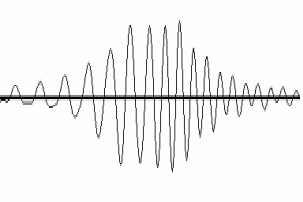The photon is an elementary particle, the force carrier of the electromagnetic interaction and the basic unit of light and all other forms of electromagnetic radiation. The photon has zero mass, and does not decay spontaneously so the electromagnetic force has infinite range, and we can see out to the edge of the Universe, 15 billion light years away, with the appropriate instruments, but has an intrinsic angular momentum of![]() which makes it a boson, not subject to Pauli's Exclusion Principle. Like all elementary particles, photons are currently best explained by quantum mechanics and will exhibit wave–particle duality — they exhibit properties of both waves and particles. For example, a single photon may be refracted by a lens or exhibit wave interference with itself, but also act as a particle giving a definite result when quantitative momentum is measured. Like all particles that observe wave particle duality, the photon obeys the equation
which makes it a boson, not subject to Pauli's Exclusion Principle. Like all elementary particles, photons are currently best explained by quantum mechanics and will exhibit wave–particle duality — they exhibit properties of both waves and particles. For example, a single photon may be refracted by a lens or exhibit wave interference with itself, but also act as a particle giving a definite result when quantitative momentum is measured. Like all particles that observe wave particle duality, the photon obeys the equation![]() and so has momentum, which means it can exert a pressure. It also obeys the uncertainty principle %DELTA E %DELTA t >=h bar over 2 which means that it's energy cannot be exactly defined. Because of this we cannot define it's frequency of wavelength exactly, and may think of the photon as a little moving wave packet with a range of wavelengths which is none zero ofver a little part of space, as shown below.
and so has momentum, which means it can exert a pressure. It also obeys the uncertainty principle %DELTA E %DELTA t >=h bar over 2 which means that it's energy cannot be exactly defined. Because of this we cannot define it's frequency of wavelength exactly, and may think of the photon as a little moving wave packet with a range of wavelengths which is none zero ofver a little part of space, as shown below.

Like all particles, in particle interactions the photon obeys the laws of conservation of momentum and energy.
The modern concept of the photon was developed gradually by to explain experimental observations that did not fit the classical wave model of light, notably the photoelectric effect. In particular, the photon model accounted for the frequency dependence of light's energy –![]() - and explained the ability of matter and radiation to be in thermal equilibrium. It also accounted for anomalous observations, including the properties of black body radiation, that other physicists, most notably Max Planck, had sought to explain using semiclassical models, in which light is still described by Maxwell's equations, but the material objects that emit and absorb light are quantized. Although these semiclassical models contributed to the development of quantum mechanics, further experiments validated Einstein's hypothesis that light itself is quantized; the quanta of light are photons.
- and explained the ability of matter and radiation to be in thermal equilibrium. It also accounted for anomalous observations, including the properties of black body radiation, that other physicists, most notably Max Planck, had sought to explain using semiclassical models, in which light is still described by Maxwell's equations, but the material objects that emit and absorb light are quantized. Although these semiclassical models contributed to the development of quantum mechanics, further experiments validated Einstein's hypothesis that light itself is quantized; the quanta of light are photons.
